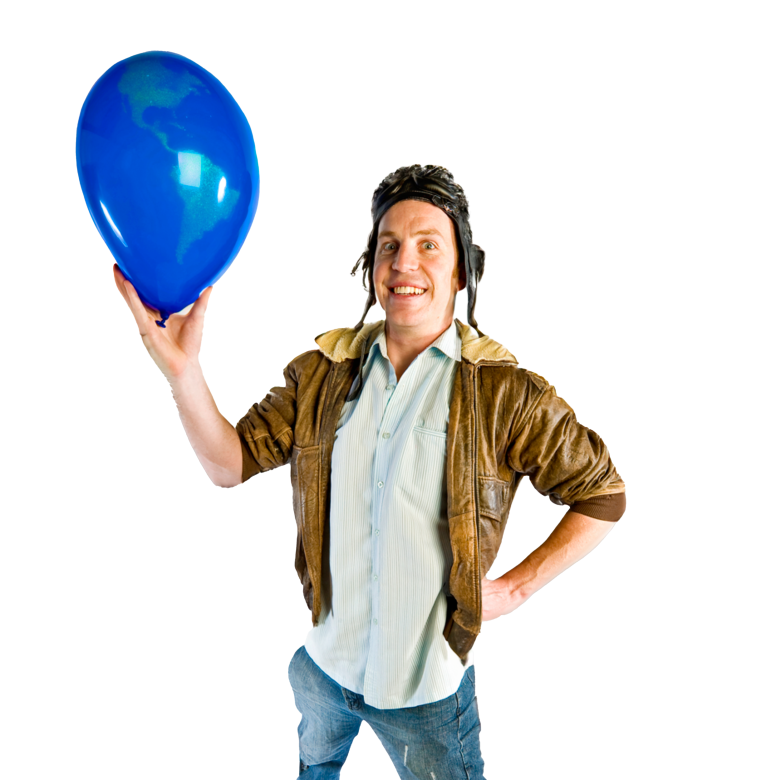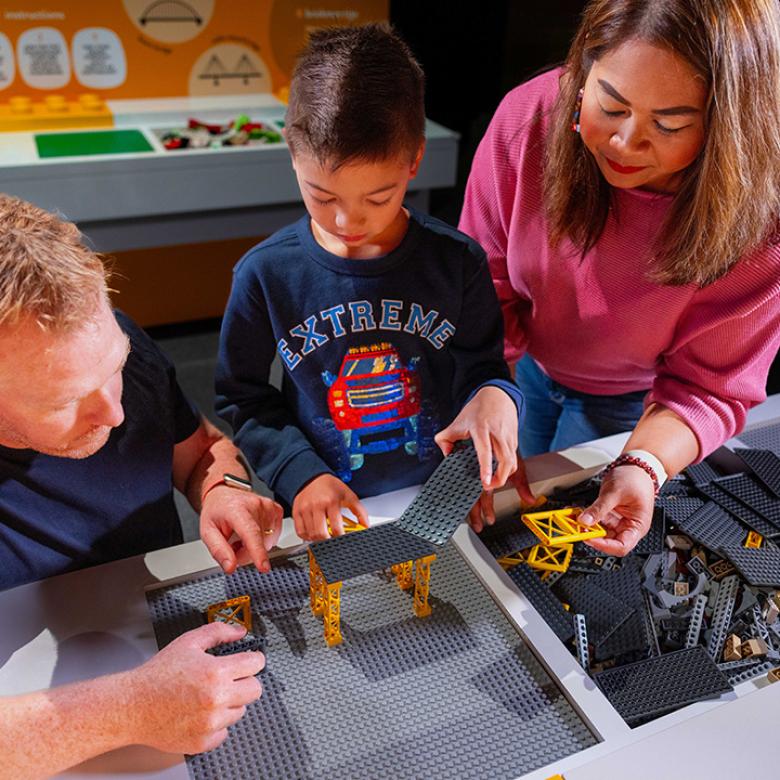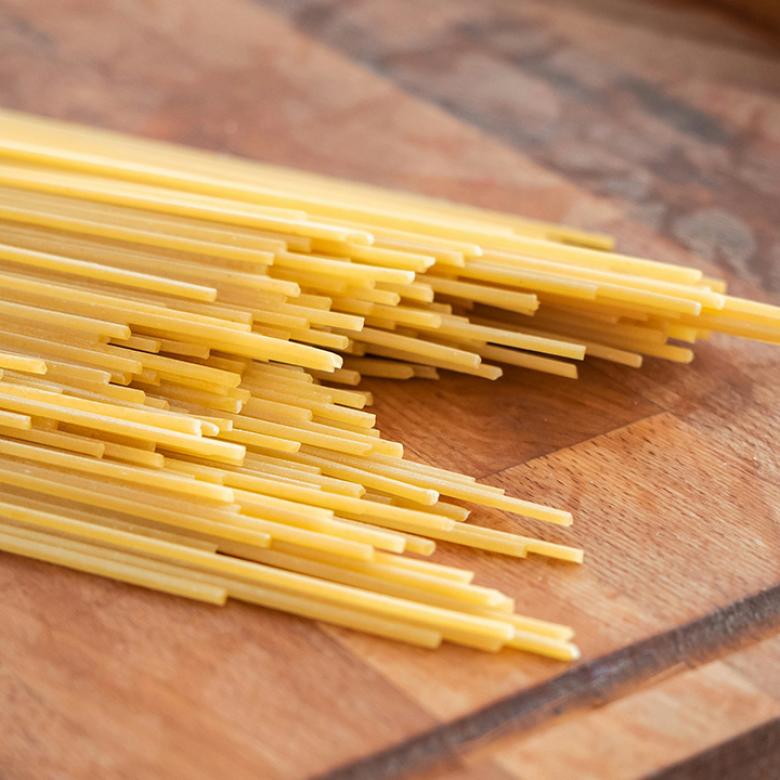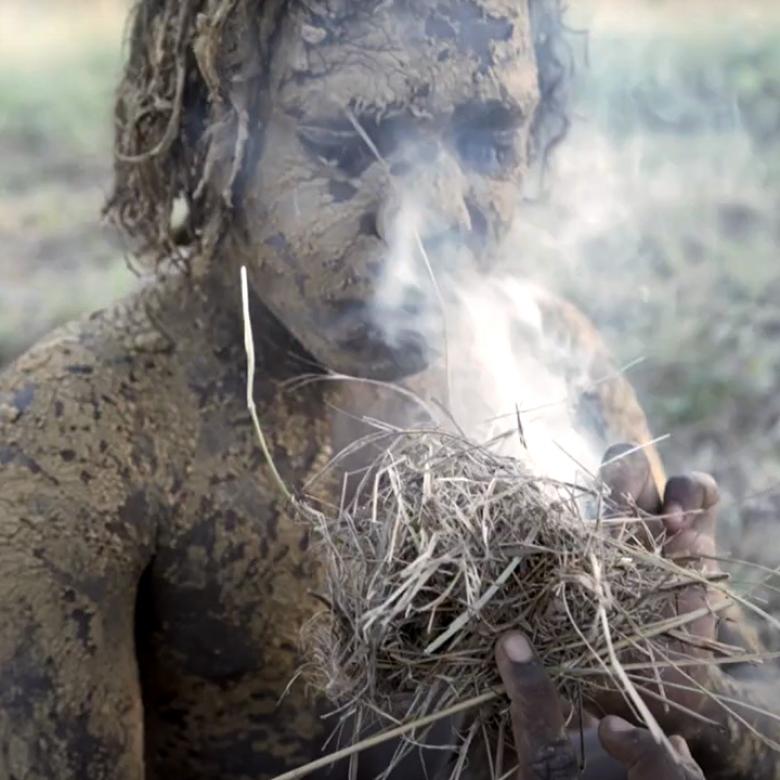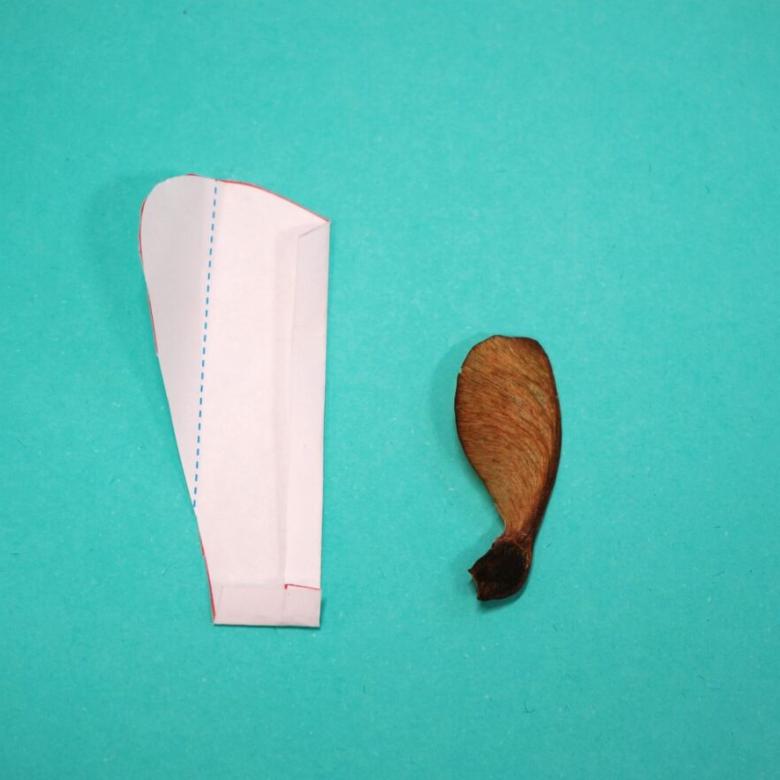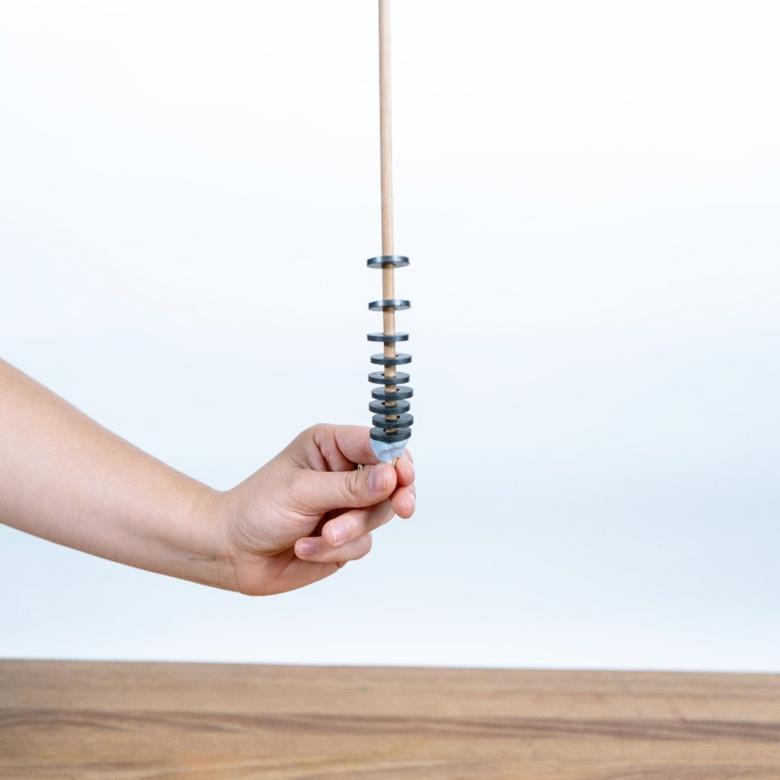You’ll need
- A balloon
- A big breath!
What to do
- Blow up your balloon.
- Hold on to the end so air doesn’t come out. Don’t let go yet!
- Countdown from 10 to 0 and let your balloon rocket go.
Questions to ask
How can you make your balloon rocket go higher? Try using a bigger balloon.
Is your balloon rocket strong enough to carry things across the room? Try attaching a very small light toy under the balloon with a piece of string and launching it. If it’s not strong enough, try using 2 balloons.
What's happening
The air rushing out of the balloon in one direction pushes the balloon in the opposite direction. This works just like a real rocket, except the real rocket pushes a lot harder. So they can go a lot faster and farther – all the way into space!
Do you love making rockets? To really see things fly, try the Pop Rocket activity
Dion: Hi boys and girls. Welcome to Questacon Science Time. My name’s Dion.
BJ: And I’m BJ
Dion: And today we’re talking about space and rockets.
BJ: Let’s go blast off!
Dion: Does anyone know what we might be talking about today? Any ideas?
Child: Rockets.
Children: Space.
Dion: Space and rockets. Exactly. We are talking about space and rockets. Can everyone be a rocket? First of all, can everyone be a rocket for me? Everyone show me your rocket. Boys and girls try to be a rocket. Show me your rocket.
BJ: Show me your rocket arms.
Dion: Now, rockets go into space. Can anyone tell me where is space?
Child: Up in the sky.
Dion: It’s up in the sky, isn’t it? So if you look up int the sky, what colour is the sky today? It’s blue, isn’t it. And beyond the blue, past all the blue, is space. Now what things do we see in space? What things are in space?
Child: Aliens.
Dion: Aliens might be in space, but we don’t really know yet though, but aliens could be in space.
Child: And rockets.
Dion: And rockets could be in space, they can.
Child: Rocks.
Dion: And rocks. There are rocks floating around in space and they can be called asteroids.
Child: Astronauts
Child: Planets.
Dion: You were right when you said planets. There are lots of planets in space as well.
BJ: I've got a photo of some planets that are out in space.
Dion: Now, does anyone know, what planet do we live on?
Child: Earth.
Dion: We live on Earth, well done.
BJ: And here is a picture of what the Earth looks like from space. You can see all the clouds floating around.
Dion: Now, on Earth, does anyone know what country we live in?
Child: Australia.
Child: Earth.
Dion: We live in Australia. So we live in Australia on Earth.
BJ: Right there.
Dion: That's us right there.
BJ: That's our home.
Dion: So, what other things can you find in space? Any ideas? What do you think?
Child: There are big round rocks.
Dion: There are big round rocks, they're the asteroids that we were talking about before.
Child: Sun.
Dion: The sun, well done.
BJ: The sun.
Dion: You can see the sun.
BJ: Here's a photo of the sun.
Dion: Can you see the sun in the day time or the night time.
Children: The day time.
Dion: You see the sun in the day time.
Child: You can see the moon at day time.
Dion: And sometimes you can see the moon in the day time as well. Is the moon in space.
Children: Yes.
Dion: It is, isn't it. The moon is in space.
Child: And you can see the moon in the morning, but only when it's summer.
Dion: You can see the moon in the day time and also in the night time.
Child: My grandpa used to have a rocket ship.
Dion: Did he used to have a rocket ship your grandpa? Very lucky grandpa.
BJ: There's a photo here of a rocket ship.
Dion: And what is this coming out the bottom of the rocket do you think?
Children: Fire.
Dion: It's fire.
Child: And smoke.
Dion: And smoke as well.
Child: I've got a book about rockets.
Dion: Do you have a book about rockets? They're lots of fun. So this rocket uses lots and lots of fire down the bottom to shoot up into the air, into space.
Child: And my sisters got a book about aeroplanes because she has to know a lot about aeroplanes.
Dion: There are lots of books about space stuff.
Child: I've got a book about aeroplanes and it's got rockets ships in it.
Dion: Rocket ships in it as well? Now what sort of things do you see twinkling in the night sky?
Children: Stars.
Dion: Stars. There are lots of stars in space. Do you know stars are actually a lot like our sun? They're actually big balls of flaming gas or burning gas and that's why they burn so brightly because they are exactly, or almost exactly, like our sun.
BJ: But they don't look like our sun because they are a long, long, long, long, long way away.
Dion: They are. They are a very , very far away.
BJ: What is somebody that flies up in space called?
Child: Eagle.
Dion: An eagle does fly. But what is a person who goes into space?
Child: An astronaut.
Dion: An astronaut, well done. Now, an astronaut is a person who goes into space from the USA. But someone from Russia can be called a cosmonaut and someone from China can be called a taikonaut. So there are lots of different kinds of "nauts" I suppose. But this is an astronaut, this on here.
BJ: There are some people that actually live in space. They live in a place called the international space station.
Dion: The international space station is a bit like a big house floating in space.
BJ: Who here would like to live in space?
Dion: I think it'd be lots of fun.
Child: It'd be lots of fun.
Dion: Yeah. I think it'd be really cool.
Child: And you could even bounce on the moon.
Dion: You could bounce on the moon.
BJ: Yes.
Child: You might even meet aliens.
Dion: You might even meet aliens if your very, very lucky.
Child: That's where rockets go up.
Dion: That's where the rockets go up to, don't they? They go up to the space station and meet other astronauts and that sort of thing. Now what we might do, were actually going to watch a video of a rocket taking off. How do astronauts get to space? Do they drive a car?
Children: No!
Dion: Do they swim to space?
Children: No!
Child: They fly in a rocket.
Dion: They do. They fly in a rocket ship, don't they. So we're going to have a look .
Child: And then when they land on a thing they get out.
Dion: They do, they get out of their rocket sometimes. So what we're going to do is we're going to look at a rocket ship blasting off. We've got a video.
BJ: I'll go press play.
Dion: So BJ's going to press play. What we're going to do, we're all going to turn on our bottoms. Can everyone turn on their bottom and have a look over there for me. So BJ's going to press play and here we've got our big rocket. And this rocket is bigger than Questacon. So ready? Counting down.
Everyone: 5…4…3…2…1... Blastoff! Now our rocket is blasting off into the sky and there's our astronaut flying the rocket. And you can see our rocket is going very, very fast indeed.
Child: And it's a red astronaut.
Dion: It is. It's a red astronaut that one. Now this rocket ship has lots of fire coming out the bottom. And when it runs out of fuel it drops off part of the rocket ship. It's burns all the fuel in that part of the rocket ship so it drops that off. And then it starts using fuel in the next part. It drops off more bits when it runs out of more fuel. And that small bit at the front is the bit where all the astronauts are. There they are. Nice and safe. They drop off the last part and the astronauts are safe in space ready to go to the moon, these astronauts. Now what they're going to do, they can use lots of things on the space ship and keep them with electricity. They're going to fold out these solar panels that make electricity from the sun. It helps them fly about the place and helps keep them safe in their spaceship.
Child: It looks like a satellite.
Dion: It looks a bit like a satellite, doesn't it? Now we're going to look at another rocket ship and we'll do our count down again, ready?
Everyone: 5…4…3…2…1... Blastoff!
Child: I know that is like the last rocket we flied.
Dion: Yeah, it's a little bit like the last one.
Child: There is smoke everywhere!
Dion: You can see the smoke and the fire coming out the bottom. This one is a little bit different. It's going very, very far from Earth. And it's going to zoom across - zoom! Really, really fast. Now this rocket will also start taking bits off when they run out of fuel.
Child: Like that part.
Dion: Yes, so it drops that part off.
Child: And then it connects it back on to a new rocket?
Dion: It does. So now what this thing is going to do, it's actually going to connect to the rocket with all the people inside it. With all the astronauts inside. So more bits drop off as well and it's going to go all the way towards the moon, which is very, very exciting indeed.
Child: And they're safe inside.
Dion: Yes, so they're safe inside. All the astronauts are safe inside.
Child: They're not going to fall out.
Dion: They're not going to fall out at all.
Child: Why does the rocket break up?
Dion: The reason the rocket breaks up is because it doesn't need those bits anymore and they are really, really heavy which makes it go a bit slower. So it wants to go a bit faster so it drops off all those bits there. Now has anyone ever seen a rocket like this before?
Children: Yes!
Dion: What rocket is this? Does anyone know?
Children: A balloon rocket.
Dion: A balloon rocket. Now, what do we have to put inside our balloon rocket for it to fly?
Children: Air.
Dion: We need air for our balloon rocket. So what we're going to do is we're going to put some air inside the balloon rocket. There we are. So, pumping the air inside. (POP!) Oh!
BJ: I'll go get another one.
Dion: That was a pretty loud rocket, wasn't it?
Child: That just hurt my ears.
Dion: Hopefully we didn't have any astronauts on that rocket.
BJ: That was a loud noise, wasn't it?
Dion: Now this one will be a lot better. I promise this one won't explode. This one will make a bit of a sound when it takes off, but I'll warn you because we'll do our count down. So here we are, we're going to pump up our rocket. Lots of air inside, there we are.
BJ: It's getting full of air.
Dion: Now before we launch our rocket what do we have to do?
Children: Count down.
Dion: We need to count down. So this rocket is going to make a bit of a sound when it takes off. We're going to count down, ready? It's going to go right to the sky. Ready?
BJ: Are you ready for count down?
Dion: Ready?
Everyone: 5.4.3.2.1. Blast off!
Dion & BJ: Wow!
Dion: Very exciting. Look at that.
Child: That's funny. That was funny.
Dion: It was funny. It sounds a bit funny, doesn't it. Thank you very much. There we are. So this rocket needed air to take off. What did the other rocket need that we looked at before? It needed fire, didn't it. It needed fire and smoke and fuel.
BJ: Fuel to make fire.
Dion: So we've got lots of things to play with in Science Time today. So find your grownups and explore the room.
BJ: Go have a play. While everyone here is playing with all our rockets inside. Dion and I are going to take you outside to launch a really high rocket. Come and see.
Dion & BJ: Hi boys and girls.
BJ: Now, Dion and I are outside Questacon to launch our really big water rocket. Now we had to come outside because this is too big to do indoors.
Dion: Much too big.
BJ: Now, we've got water in our rocket and we're going to pump some air in there as well. Now, as I pump air into the rocket you can see the air bubbles in the water. Lots of air going into this rocket. And the air pressure is getting higher and higher. All those air molecules are getting squashed together inside the rocket. Oh, it's getting a bit hard to pump now, I think it's as full as it's going to be. Now, what we're going to do, we're going to launch our rocket. And when we do all the air and the water are going to push out the bottom. All the air and water will go down and that will push the rocket up into the sky. But we've got to do our count down.
Dion: We do.
BJ: Are we ready?
BJ & Dion: 5.4.3.2.1.0. Blast off! Wow!
Dion: So we've played with lots of different things at Science Time today. But we've got one more thing to look at. Today we're going to make our own rocket ship today, which is really exciting. Now, instead of using fire, like we saw in the video, we're going to use something else. We're going to use some water and a fizzy tablet.
BJ: This is called a chemical rocket because they're going to combine, they're going to react and make a gas.
Dion: So what we've got here is a film canister or a little container with a lid. And we're going to put a fizzy tablet inside. Then we're going to put the lid back on top and trap all the fuzziness. The air is going to get really, really squished inside and hopefully our rocket ship will take off, we'll see. So we might put our…
BJ: Yes. I'll put it in. And once it starts fizzing the gas is going to build up and build up and build up and what will happen when this little film canister can't hold all that gas?
Child: Blast!
BJ: Blast off!
Dion: Blast off.
BJ: For this one, let's all move back.
Dion: Can you move back a little bit.
BJ: Move back. Way back. And we'll move back too in a moment.
Dion: We will.
BJ: Way back, wiggle, wiggle. Now, make sure if you do this at home you have mummy or daddy or a grownup close by.
Dion: It's very important to have mum or dad near.
BJ: Once you've put the fizzy tablet in you can't go looking at your rocket because it might blast off and hit you in the head. So once we've put it in there, we're going to move away. And we don't know when it's going to launch off.
Dion: So it's a bit of a tricky rocket. We don't know when it's going to take off. We can't do a countdown for this one.
BJ: No.
Dion: But when it does it will be pretty exciting.
BJ: So are you watching. We'll put the fizzy tablet in and the lid on tight. Give it a shake and move back, move back.
Dion: Shuffling back. Inside the film canister the fizzy tablet is making lots and lots of gas. It's getting really, really squishy inside until eventually all the gas will push on itself. And it will shoot up because the pressure is so high. Now… Whoh! Very exciting indeed.
Child: There's some gunk on the chair.
Dion: There is, it's gunky isn't it? Lots of fun.
BJ: Wow!
Dion: I think that one hit the roof. I think it would have gone to space actually, that one there. So, coming and sitting everyone. Come a little bit closer.
BJ: Come back in.
Child: That was funny.
BJ: That was funny.
Dion: It was a bit funny, wasn't it?
BJ: That was a fun one.
Child Scary.
Dion: A bit scary but very, very safe though. So if you want to give that one a go at home what we used was an aspirin tablet, a film canister and some water. But do be careful and make sure mum or dad are there to help you with that experiment.
BJ: And what don't you do?
Dion: Look over the rocket.
BJ: You don't look over the rocket. Well done. Make sure you've got a grownup.
Dion: So, first of all, things that we've got to give away today. We've got a parent information sheet. And it gives you some ideas of where to go and what to do in order to learn more about space, which is really, really good fun. So make sure to check that one out. And we've also got a colouring in sheet today as well. Now, can anyone tell me what's this big thing here?
Children: The moon.
Dion: It's the moon, well done. And what are these sparkly things around the moon?
Children: Stars.
Dion: Stars. And what's this big thing blasting off at the bottom?
Children: A rocket.
Dion: A rocket. So you can have one of these. Boys and girls you can down load them from the internet. And take them home and colour them in. Sitting down on your bottoms. What we're going to do first is say goodbye to the boys and girls. Can everyone say goodbye?
BJ: Turn and wave.
Dion: Waving. See you next Science Time.
BJ & Children: See you next Science Time.
Dion: So who would like a colouring in sheet? Would you like one?
BJ: Come and get a colouring in sheet.

